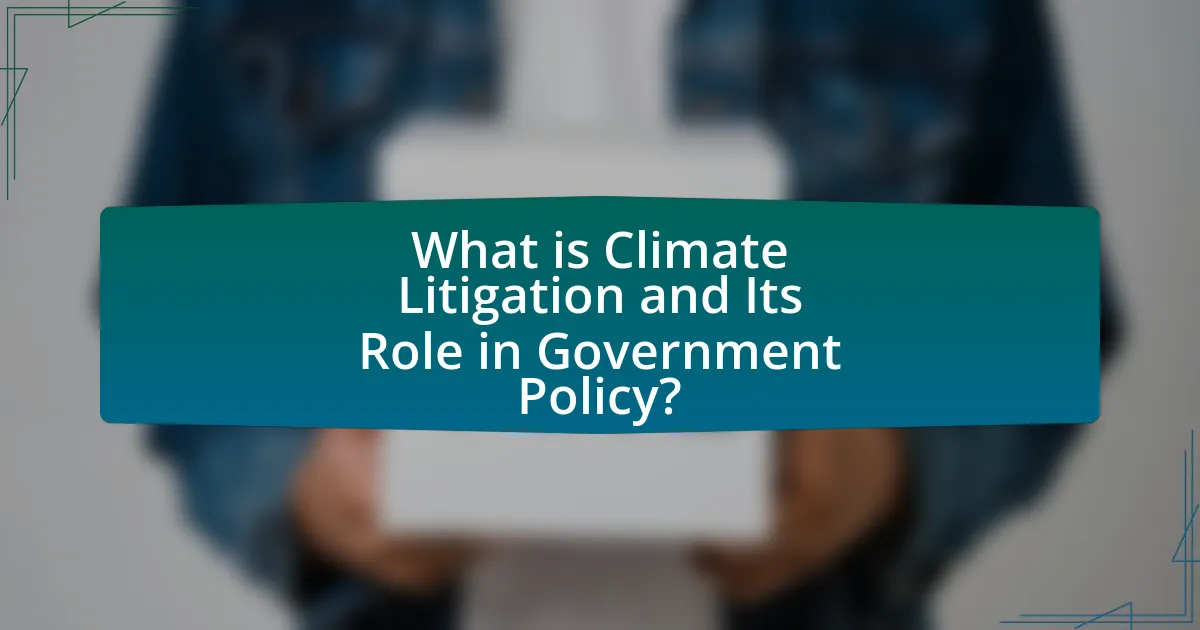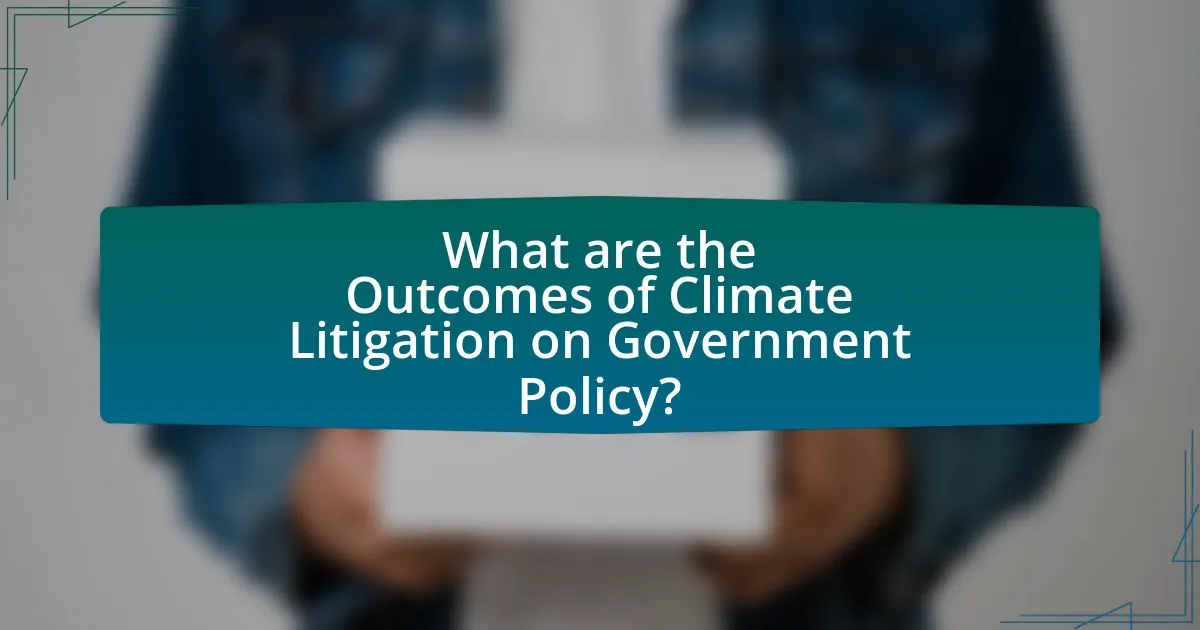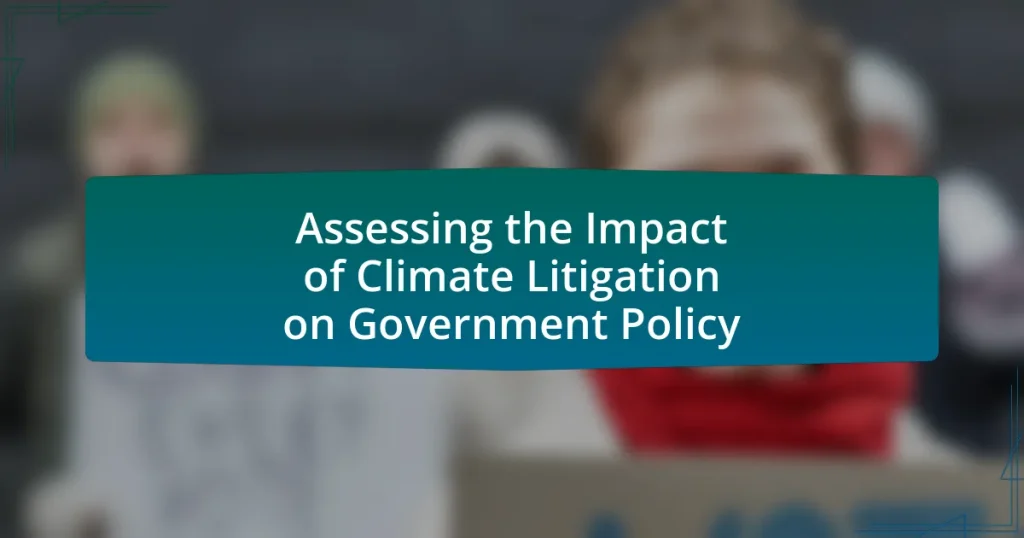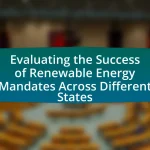Climate litigation refers to legal actions aimed at holding governments and corporations accountable for their contributions to climate change and compelling them to take action. This article assesses the impact of climate litigation on government policy, highlighting how such legal actions influence decision-making, prompt regulatory changes, and lead to the adoption of more ambitious climate targets. Key legal frameworks, notable court rulings, and the increasing prevalence of climate lawsuits are examined, along with the challenges faced in these cases and strategies to enhance their effectiveness. The article also discusses the role of advocacy groups and public perceptions in shaping climate litigation outcomes and the long-term implications for environmental policy.

What is Climate Litigation and Its Role in Government Policy?
Climate litigation refers to legal actions taken to hold governments and corporations accountable for their contributions to climate change and to compel them to take action to mitigate its effects. This form of litigation plays a significant role in shaping government policy by influencing legislative frameworks, prompting regulatory changes, and encouraging the adoption of more ambitious climate targets. For instance, landmark cases like Urgenda Foundation v. State of the Netherlands have resulted in judicial mandates for governments to reduce greenhouse gas emissions, thereby directly impacting national climate policies. Such legal actions serve as a catalyst for policy reform by highlighting the legal obligations of governments to protect citizens from climate-related harms, thus reinforcing the necessity for comprehensive climate action.
How does climate litigation influence governmental decision-making?
Climate litigation influences governmental decision-making by compelling governments to adopt stricter environmental regulations and policies. Legal actions taken by individuals, organizations, or states against governments or corporations often highlight failures to meet climate commitments or protect public health, prompting legislative and regulatory responses. For instance, the Urgenda Foundation’s lawsuit against the Dutch government resulted in a court ruling that mandated the government to reduce greenhouse gas emissions by at least 25% by 2020 compared to 1990 levels, demonstrating how judicial decisions can directly impact policy frameworks. Such litigation not only raises public awareness but also creates legal precedents that encourage other jurisdictions to enhance their climate policies, thereby shaping a more robust governmental approach to climate change.
What are the key legal frameworks surrounding climate litigation?
The key legal frameworks surrounding climate litigation include international treaties, national laws, and judicial precedents that govern environmental protection and climate change accountability. Internationally, the Paris Agreement establishes commitments for countries to reduce greenhouse gas emissions, while national laws, such as the Clean Air Act in the United States, provide regulatory mechanisms for enforcing environmental standards. Judicial precedents, such as the Urgenda case in the Netherlands, demonstrate how courts can compel governments to take action on climate change based on existing legal obligations. These frameworks collectively shape the landscape of climate litigation by defining the legal responsibilities of governments and corporations in addressing climate-related issues.
How do court rulings impact policy changes?
Court rulings significantly impact policy changes by establishing legal precedents that compel governments to alter existing laws or implement new regulations. For instance, landmark cases such as Massachusetts v. EPA (2007) mandated the Environmental Protection Agency to regulate greenhouse gas emissions, directly influencing U.S. climate policy. These rulings can also prompt legislative bodies to respond to judicial decisions, leading to reforms that align with judicial interpretations of existing laws. The influence of court rulings on policy is evident in various sectors, including environmental law, where judicial decisions often catalyze governmental action to address climate change and enforce compliance with international agreements.
Why is climate litigation becoming more prevalent?
Climate litigation is becoming more prevalent due to increasing public awareness of climate change impacts and the growing recognition of legal accountability for environmental harm. As scientific evidence of climate change intensifies, individuals and organizations are increasingly using the legal system to hold governments and corporations accountable for their contributions to climate-related issues. For instance, a report by the Grantham Research Institute on Climate Change and the Environment indicates that the number of climate-related lawsuits has surged globally, with over 1,500 cases filed as of 2021. This trend reflects a shift in societal attitudes towards demanding action on climate change through legal channels, thereby influencing government policy and corporate practices.
What social and environmental factors contribute to the rise of climate litigation?
The rise of climate litigation is primarily driven by increasing public awareness of climate change and its impacts, alongside growing environmental degradation. Social factors include heightened activism and advocacy from communities affected by climate-related events, which has led to a demand for accountability from corporations and governments. Environmental factors encompass the observable consequences of climate change, such as extreme weather events, rising sea levels, and biodiversity loss, which have prompted legal actions to enforce environmental regulations and policies. For instance, the 2019 case of Urgenda Foundation v. State of the Netherlands highlighted how citizens successfully held their government accountable for inadequate climate action, reflecting both social mobilization and environmental urgency.
How do public perceptions of climate change affect litigation efforts?
Public perceptions of climate change significantly influence litigation efforts by shaping the legal landscape and the willingness of courts to hear cases. When public concern about climate change is high, it often leads to increased support for legal actions aimed at holding corporations and governments accountable for environmental harm. For instance, a study by the Yale Program on Climate Change Communication found that 70% of Americans believe that climate change is affecting their local community, which correlates with a rise in climate-related lawsuits. This heightened awareness can result in more robust legal arguments and greater public backing for litigation, thereby increasing the likelihood of successful outcomes in court. Additionally, favorable public sentiment can pressure policymakers to enact laws that facilitate climate litigation, further enhancing the effectiveness of legal efforts against climate change.

What are the Outcomes of Climate Litigation on Government Policy?
Climate litigation leads to significant changes in government policy by compelling authorities to enhance climate regulations and accountability. For instance, landmark cases like Urgenda Foundation v. State of the Netherlands resulted in the Dutch government being ordered to reduce greenhouse gas emissions by at least 25% by 2020 compared to 1990 levels, demonstrating how legal actions can enforce stricter environmental standards. Additionally, climate lawsuits have prompted governments to adopt more ambitious climate action plans, as seen in various countries where courts have ruled in favor of citizens demanding stronger climate policies. These outcomes illustrate that climate litigation serves as a powerful tool for influencing governmental approaches to climate change and environmental protection.
What specific policy changes have resulted from climate litigation?
Climate litigation has led to specific policy changes, including the implementation of stricter emissions regulations and enhanced climate action plans by governments. For instance, in 2021, the Dutch court mandated Shell to reduce its carbon emissions by 45% by 2030 compared to 2019 levels, prompting the company to revise its climate strategy. Similarly, in the United States, various states have adopted more aggressive renewable energy targets and carbon neutrality goals following successful lawsuits against fossil fuel companies, demonstrating a direct influence of litigation on policy frameworks.
How have different countries responded to climate litigation outcomes?
Countries have responded to climate litigation outcomes with varying degrees of policy adjustments and legal reforms. For instance, in the Netherlands, the Supreme Court’s ruling in the Urgenda case mandated the government to reduce greenhouse gas emissions by at least 25% by 2020 compared to 1990 levels, leading to significant changes in national climate policy. Similarly, in Germany, the Federal Constitutional Court ruled that the existing climate protection law was insufficient, prompting the government to revise its climate targets to achieve carbon neutrality by 2045. In contrast, some countries, like the United States, have seen mixed responses, where certain states have enacted stricter regulations following court rulings, while others have resisted changes, reflecting a fragmented approach to climate litigation outcomes. These responses illustrate how judicial decisions can catalyze or hinder climate policy reforms across different nations.
What are the long-term implications of these policy changes?
The long-term implications of policy changes resulting from climate litigation include enhanced regulatory frameworks, increased accountability for greenhouse gas emissions, and a shift towards sustainable practices in various sectors. These changes often lead to stricter environmental standards, as governments respond to legal pressures and public demand for action on climate change. For instance, following significant climate lawsuits, jurisdictions have implemented policies that mandate reductions in carbon emissions, which can result in a measurable decrease in pollution levels over time. Additionally, these policy shifts can stimulate innovation in green technologies and renewable energy, fostering economic growth while addressing environmental concerns. Historical examples, such as the 2007 Massachusetts v. EPA case, demonstrate how litigation can compel regulatory agencies to take action, ultimately reshaping national climate policy.
How does climate litigation affect the legislative process?
Climate litigation significantly influences the legislative process by compelling lawmakers to address climate change more urgently and effectively. Legal actions against governments and corporations often highlight regulatory gaps and failures, prompting legislative bodies to introduce or amend laws aimed at reducing greenhouse gas emissions and enhancing environmental protections. For instance, the 2015 case of Massachusetts v. EPA led to the U.S. Environmental Protection Agency’s (EPA) authority to regulate carbon dioxide emissions, showcasing how litigation can drive legislative action. Furthermore, climate lawsuits can mobilize public opinion and increase pressure on legislators to prioritize climate policies, thereby accelerating the adoption of comprehensive climate legislation.
What role do advocacy groups play in shaping legislation through litigation?
Advocacy groups play a crucial role in shaping legislation through litigation by using legal action to influence policy outcomes and hold governments accountable. These organizations often file lawsuits to challenge laws or regulations that they believe are inadequate or harmful, particularly in the context of climate change. For example, the landmark case Massachusetts v. EPA (2007) saw advocacy groups successfully argue that the Environmental Protection Agency had the authority to regulate greenhouse gas emissions, leading to significant changes in federal policy. This demonstrates how litigation can compel legislative bodies to address pressing environmental issues, thereby shaping the legal landscape surrounding climate policy.
How can litigation lead to proactive policy measures?
Litigation can lead to proactive policy measures by compelling governments and organizations to address legal obligations and societal expectations regarding environmental protection. When courts rule in favor of plaintiffs in climate litigation cases, such as those involving emissions reductions or climate adaptation, they create legal precedents that require policymakers to implement more stringent regulations. For instance, the 2018 case of Urgenda Foundation v. State of the Netherlands resulted in a court order mandating the Dutch government to reduce greenhouse gas emissions by at least 25% by 2020 compared to 1990 levels. This ruling not only enforced immediate action but also encouraged other nations to adopt similar proactive measures in response to climate change, demonstrating how litigation can effectively drive policy reform.

What Challenges and Limitations Exist in Climate Litigation?
Climate litigation faces several challenges and limitations, primarily including legal standing, evidentiary burdens, and jurisdictional issues. Legal standing often restricts who can bring a case, as plaintiffs must demonstrate a direct injury caused by climate change, which can be difficult to prove. Additionally, the evidentiary burden requires plaintiffs to establish a clear causal link between specific actions and climate impacts, a task complicated by the multifaceted nature of climate science. Jurisdictional issues arise when cases are filed in courts that may not have the authority to adjudicate environmental matters, leading to inconsistent rulings across different regions. These challenges hinder the effectiveness of climate litigation as a tool for driving policy change.
What are the common obstacles faced in climate litigation cases?
Common obstacles faced in climate litigation cases include legal standing, evidentiary challenges, and the complexity of proving causation. Legal standing often limits who can bring a case, as plaintiffs must demonstrate a direct injury from climate change impacts. Evidentiary challenges arise from the difficulty in obtaining concrete evidence linking specific climate-related damages to the actions of defendants, such as corporations or governments. Additionally, proving causation is complex due to the multifaceted nature of climate change, where multiple factors contribute to environmental harm, making it hard to attribute responsibility to specific entities. These obstacles hinder the effectiveness of climate litigation in driving policy change.
How do legal costs and resources impact the ability to litigate?
Legal costs and resources significantly impact the ability to litigate by determining whether individuals or organizations can afford to pursue legal action. High legal fees can deter potential litigants from initiating lawsuits, particularly in complex cases like climate litigation, where costs can escalate quickly due to expert testimonies and extensive research. For instance, a study by the World Bank indicated that legal costs can consume up to 20% of a litigant’s total budget, limiting access to justice for those with fewer financial resources. Consequently, the disparity in financial capabilities can lead to unequal representation in court, affecting the overall effectiveness of litigation aimed at influencing government policy on climate issues.
What challenges arise from jurisdictional differences in climate law?
Jurisdictional differences in climate law create challenges such as inconsistent regulations, enforcement difficulties, and legal uncertainty. These variations can lead to a patchwork of climate policies that complicate compliance for businesses operating across multiple regions. For instance, companies may face conflicting requirements in different jurisdictions, which can hinder their ability to implement effective climate strategies. Additionally, the lack of a unified legal framework can result in varying interpretations of climate obligations, creating confusion and potential litigation risks. This inconsistency undermines the effectiveness of climate action and can delay progress toward global climate goals.
How can these challenges be addressed to enhance the effectiveness of climate litigation?
To enhance the effectiveness of climate litigation, legal frameworks must be strengthened to support claims related to climate change. This can be achieved by establishing clearer legal standards for environmental harm and expanding the scope of standing, allowing more individuals and organizations to bring forth cases. For instance, jurisdictions that have recognized the rights of nature or granted standing to youth activists have seen increased success in litigation outcomes. Additionally, integrating scientific evidence into legal arguments can bolster cases; studies show that courts are more likely to rule favorably when presented with robust scientific data linking climate change to specific harms. Furthermore, fostering collaboration among NGOs, legal experts, and scientists can create a more unified approach to litigation, increasing its impact on government policy.
What strategies can be employed to improve access to climate litigation?
To improve access to climate litigation, strategies such as enhancing legal aid services, simplifying legal processes, and increasing public awareness can be employed. Enhancing legal aid services ensures that marginalized communities have the resources to pursue litigation, as evidenced by studies showing that legal representation significantly increases the likelihood of successful outcomes in environmental cases. Simplifying legal processes can reduce barriers for individuals and organizations seeking to file claims, as complex procedures often deter potential litigants. Increasing public awareness through educational campaigns can empower citizens to understand their rights and the importance of climate litigation, which has been shown to mobilize community action and support for legal initiatives.
How can collaboration between stakeholders strengthen litigation efforts?
Collaboration between stakeholders can strengthen litigation efforts by pooling resources, expertise, and information, which enhances the overall effectiveness of legal strategies. When various stakeholders, such as environmental organizations, legal experts, and affected communities, work together, they can create a more comprehensive case that addresses multiple facets of an issue. For instance, a study by the Sabin Center for Climate Change Law highlights that collaborative litigation efforts have led to significant legal victories, as seen in cases where diverse groups united to challenge government policies on climate change. This collective approach not only amplifies the voices of those impacted but also increases the likelihood of achieving favorable outcomes in court.
What Best Practices Can Enhance the Impact of Climate Litigation on Government Policy?
Best practices that can enhance the impact of climate litigation on government policy include strategic framing of legal arguments, building coalitions with diverse stakeholders, and leveraging public support through awareness campaigns. Strategic framing ensures that climate litigation is presented in a way that resonates with legal precedents and public values, increasing the likelihood of favorable outcomes. Building coalitions with environmental groups, scientists, and affected communities amplifies the voices and resources available for litigation, creating a stronger case. Additionally, leveraging public support through awareness campaigns can mobilize community engagement and pressure policymakers to act, as seen in cases like the Urgenda Foundation v. State of the Netherlands, where public sentiment played a crucial role in the court’s decision to mandate stronger climate action.


